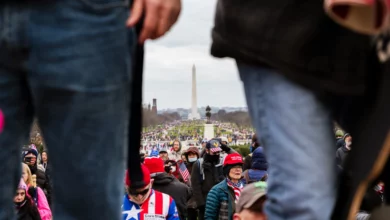
The US government has shut down once again after the Senate failed to pass a stop-gap spending measure. The Senate has since voted to pass the bill, sending it to the House where it could face further roadblocks.
The US government shut down for the second time in 2018 on Friday, after Republican Senator Rand Paul held up voting on a two-year budget deal that would have averted it.
Paul, a fiscal conservative from the state of Kentucky, said he could not allow a quick vote to take place because the proposed measure — which would fund the government for another six weeks — would also expand the US deficit.
“I ran for office because I was very critical of President Obama’s trillion-dollar deficits,” he said. “Now we have Republicans hand in hand with Democrats offering us trillion-dollar deficits.”
“I can’t… in good faith, just look the other way because my party is now complicit in the deficits. Really, who is to blame? Both parties.”
US lawmakers will hope the shutdown remains brief. Sentate officials subsequently held a vote at 1 a.m. local time (0600 UTC) to pass the budget the bill by 71 votes to 28. The measure will now be sent to the House of Representatives.
Its passage through the House is by no means assured, however. The left flank of the Democrats and the Republican’s fiscally conservative Tea Party wing have already voiced their intention to vote against the bipartisan bill.
The US Office of Management and Budget (OMB) ordered federal agencies to close and execute their contingency plans. In a notice to federal employees, OMB Director Mick Mulvaney said staff should report to work to “undertake orderly shutdown activities,” adding that his office was “hopeful that this lapse in appropriations will be of short duration.”
Deficit discontent
Democratic and Republican Senate leaders cobbled together the budget deal on Wednesday. It would raise military and domestic spending by nearly $300 billion (€250 billion) over two years.
The measure, which is backed by US President Donald Trump, did not include any spending cuts or new tax revenues. The absence of any offsetting measures, combined with far-reaching tax cuts passed at the end of 2017, would force the US to finance the increased spending through debt.
To permit the spending, the deal would also raise the limit on how much debt the government can acquire until March 2019. Total US debt currently stands at more than $20 trillion. The sweeping tax overhaul bill that Trump and Republicans approved in December is also estimated to add another $1.5 trillion to the debt over 10 years.
House Republicans, Democrats unhappy
The Senate had been expected to pass the budget deal on Thursday, allowing first the House of Representatives and then President Trump to follow suit.
But passage in the House was not assured amid opposition from some Republican and Democratic lawmakers.
Members of the “Freedom Caucus” — a group of fiscally conservative House Republicans — announced they would oppose the measure, citing the projected increase in the government deficit.
Some Democrats, including minority leader Nancy Pelosi, also said they opposed the measure because it did not include a deal that would protect some 700,000 “Dreamers” — immigrants brought to the US illegally as children — from deportation. Trump has vowed to end the so-called Deferred Action for Childhood Arrivals, or DACA, program, by March 5.
Shutdown drama
The government was forced to shut down for three days in mid-January after the Senate failed to pass a stopgap budget amid Democratic demands for a deal to protect “Dreamers.”
Democrats abandoned their opposition after three days, allowing the Senate and House to pass a temporary spending bill on January 23.




